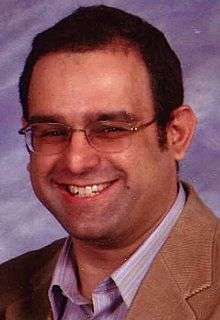David Lary
| David Lary | |
|---|---|
 David Lary | |
| Born | December 7, 1965 |
| Nationality | British and American |
| Fields | Physics, chemistry, computing, remote sensing |
| Alma mater |
King's College London University of Cambridge |
| Doctoral advisor | John A Pyle |
| Known for | Chemical data assimilation and machine learning |
David Lary (born 7 December 1965) is an atmospheric scientist interested in applying computational and information systems to facilitate discovery and decision support in Earth system science. His main contributions have been to highlight the role of carbonaceous aerosols in atmospheric chemistry,[1] heterogeneous bromine reactions,[2] and to employ chemical data assimilation for satellite validation,[3] and the use of machine learning for remote sensing applications.[4] He is author of AutoChem,[5] NASA release software that constitutes an automatic computer code generator and documentor for chemically reactive systems. It was designed primarily for modeling atmospheric chemistry, and in particular, for chemical data assimilation.
AutoChem has won five NASA awards and has been used to perform long term chemical data assimilation of atmospheric chemistry and in the validation of observations from the NASA Aura satellite. It has been used in numerous peer reviewed articles.
David Lary completed his education in the United Kingdom. He received a first class double honors BSc in physics and chemistry from King's College London (1987) with the Sambrooke Exhibition Prize in Natural Science, and a PhD in atmospheric chemistry from the University of Cambridge, Department of Chemistry while at Churchill College (1991). His thesis described the first chemical scheme for the ECMWF numerical weather prediction model. He then held post-doctoral research assistant and associate positions at the University of Cambridge until receiving a Royal Society research fellowship in 1996 (also at Cambridge). From 1998 to 2000 he held a joint position at Cambridge and the University of Tel-Aviv as a senior lecturer and Alon fellow. In 2001 he joined UMBC/GEST as the first distinguished Goddard fellow in earth science. Between 2001 and 2010 he was part of various branches at NASA Goddard Space Flight Center including the Global Modeling and Assimilation Office, the Atmospheric Chemistry and Dynamics Branch, the Software Integration and Visualization Office, and the Goddard Earth Sciences (GES) Data and Information Services Center (DISC).
In 2010 he moved to the William B. Hanson Center for Space Sciences at the University of Texas at Dallas, where he has focused on the health effects of atmospheric particulates, and developing a fleet of unmanned aerial vehicles for a variety of agricultural, environmental, and meteorological applications.
References
- ↑ Lary et al., Carbon aerosols and atmospheric photochemistry, Journal of Geophysical Research-Atmospheres, Volume 102, Issue D3, Pages 3671-3682, 1997 http://www.mendeley.com/research/carbon-aerosols-atmospheric-photochemistry/
- ↑ Lary, D. J., Chipperfield, M. P., Toumi, R., & Lenton, T. (1996). Heterogeneous atmospheric bromine chemistry, 101(D1), 1489-1504 http://www.agu.org/pubs/crossref/1996/95JD02839.shtml/
- ↑ Fisher & Lary, Lagrangian 4-Dimensional Variational Data Assimilation of Chemical-Species, Quarterly Journal of the Royal Meteorological Society, Volume 121, Issue 527, Pages 1681-1704, 1995 http://www.mendeley.com/research/lagrangian-4dimensional-variational-data-assimilation-chemical-species/
- ↑ http://www.intechopen.com/articles/show/title/artificial-intelligence-in-geoscience-and-remote-sensing
- ↑ http://www.science-softcon.de/autochem/download.html
External links
- ISI publication list
- Google Scholar page
- Mendeley publication list
- UTD faculty page
- Personal page
- UTD Mints (His consortium)
- Build UAS (Website run by his students)